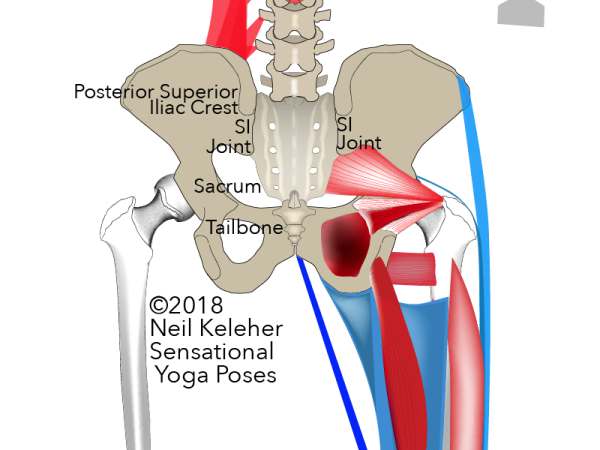Single SI Joint Stabilization
Stabilizing the same side Hip Joint and SI Joint
It is possible to stabilize a single SI joint. Generally, using the lower transverse abdominis in combination with either the pelvic floor muscles or the sacral multifidus stabilizes both SI Joints. To stabilize a single SI joint, muscles that work across the hip joint can be called into play.
Single sided SI Joint stabilization relies on hip muscle activation and opposition. This can be very useful in asymmetric poses whether sitting or standing, in particular where one leg generates a lot of torque on one side of the hip, or where both legs apply torque in opposite directions to each hip bone.
Gluteus Maximus and SI Joint Stabilization
Hip muscles that directly connect to the sacrum include some fibers of the gluteus maximus, and the piriformis. The relevant gluteus maximus fibers may be the same fibers that attach to the IT band. Even though these fibers attach more to the knee than the hip, they can be affected by the underlying fibers of the gluteus maximus that do attach to the femur.
Activation of these deeper muscles may add tension to the more superficial fibers via inflation. The superficial fibers can then act to pull the sacrum towards the hip bone on that side.
Assuming the pelvis isn't allowed to rotate relative to the thigh, this can help to stabilize the SI joint on that side. Because of the bulk of the deeper fibers of the gluteus maximus, tension added to the superficial fibers of this same muscle may create a backwards (as well as outwards) pull on the sacrum.
Since the piriformis attaches to the front surface of the sacrum, it's activation may cause more of a forwards (and lateral) pull. So these muscles could work against each other to help stabilize the SI joint in the front-to-back plane.
Both of these muscles (gluteus maximus and piriformis) tend to try to externally rotate the thigh when activated. So to stabilize the SI Joint, internal rotation is required to give these muscles an opposing force to work against.
Increasing Sacrotuberous Ligament Tension for Increased SI Joint Stabilization
The sacrotuberous ligament attaches close to the sitting bone at the ischial spine. The ischial spine is the projection that separates the opening that the piriformis passes through from the opening at the back of the pelvis that the obturator internus passes through. It also attaches to the sacrum.
If tension is added to this ligament it can help pull the wedge of the sacrum tighter in between the two hip bones.
Since there is a whole mass of connective tissue holding the sacrum in place, any displacement of the the sacrum will add tension to this network. Tension added to the sacrotuberous ligament helps to achieve this while at the same time adding additional stability to the SI joint via that same tension.
Activating Obturator Internus
In symmetrical standing positions (mountain or standing forward bend) it's fairly easy to add tension to this ligament on both sides of the body by creating an outwards pull on the sitting bones. This pulls the sitting bones away from the sacrum adding tension to the ligament.
Pulling the sit bones outwards is done by the obturator internus (assisted by the gemelli and possibly the quadratus femoris).
Doing this same activation one leg at a time, the important idea is to again resist rotation of the pelvis relative to the thigh (or vice versa). Since the obturator internus attaches to a large portion of the inner surface of the pelvis, it needs either the pelvis or the thigh to be stable so that it can pull the sitting bone outwards relative to the sacrum.
Anchoring the Gluteus Maximus and Hamstring Muscles
Note that fibers of the gluteus maximus attach to the sacrotuberous ligament as well as the hamstring muscles. Adding tension to the sacrotuberous ligament potentially gives these muscles an anchor from which to work across the back of the hip joint and, for the hamstrings, the back of the knee.
Now another possibility is to stabilize the lower leg and thigh.
Anchoring the Lower Leg and Thigh
With the leg bones stable, the gluteus maximus and hamstrings have an anchor point from which they can be used to pull on the sacrotuberous ligament. This then can stabilize the sacrum from the bottom.
Note that stabilizing the lower leg and femur also gives the IT band and the pes anserinus muscles an anchor point from which they all can act together to stabilize the pelvis.
So a general set of guidelines for working on single si joint stability is to either stabilize the hip joint so that the glute max, piriformis and/or obturator internus can be used to stabilize the SI joint. Or stabilize the lower leg and thigh (foot, ankle and knee).
With these guidelines it's not so much what poses you use but what you do in those poses so that your SI joint is stable.
Published: 2020 08 14



